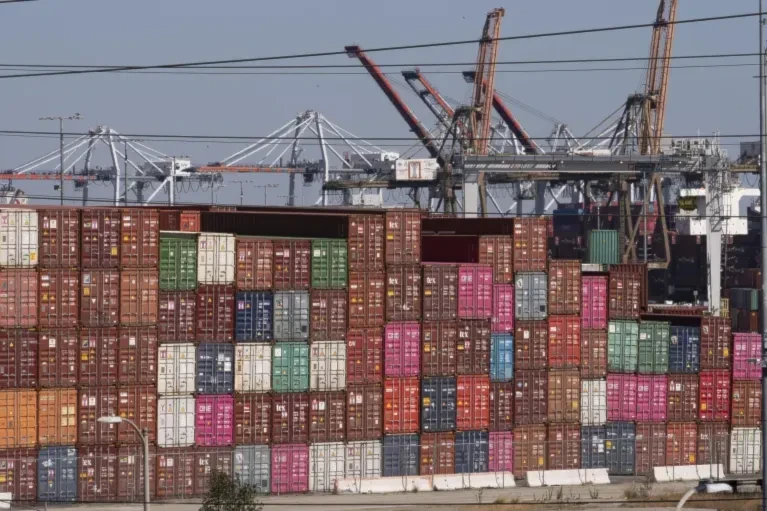Trump’s tariffs hit Port of Los Angeles hard as trade slows sharply
The Port of Los Angeles sees sharp shipping declines as Trump’s 145% tariffs on Chinese goods disrupt supply chains and spark widespread job losses.
-

Cargo containers sit stacked at the Port of Los Angeles in San Pedro, California, October 19, 2021. (AP)
The Port of Los Angeles, the busiest container port in the United States, is among the first visible casualties of President Donald Trump’s trade war, according to The Washington Post. On a spring morning when the docks should be fully active, more than half of the port’s berths sit empty, with idle cranes frozen in place, a striking visual of stalled global trade.
The Washington Post reported that the number of containers arriving at the port last week was roughly one-third lower than the same time last year, outpacing even the declines seen during the Great Recession. Additionally, over one-fifth of the ships scheduled to dock this month have already canceled their visits.
According to The Post, Trump’s 145% tariffs on Chinese imports and China’s retaliatory triple-digit duties have disrupted the steady flow of goods that has long powered the trans-Pacific trade route. Electronics, clothing, machinery, and furniture are just some of the affected categories. The result is a dramatic slowdown not only at the ports but across the entire supply chain.
Joseph Gregorio Jr., COO of the Pacific Companies, told The Washington Post that the situation is unsustainable and warned that the availability of basic goods could be threatened in a matter of weeks.
Dockworkers, truckers, and logistics firms face layoffs
One in every nine jobs in Southern California’s five-county region is tied to port activity, The Washington Post noted. The slowdown has already forced dockworkers to cut hours and trucking companies to reduce fleet sizes or abandon payments on idle vehicles. The Post describes how truckers are now returning their keys to banks rather than continuing loan payments on surplus equipment.
Union officials told The Washington Post that dockworker shifts have plummeted, with only 33 longshore gangs deployed on a recent Friday compared to 50 in mid-April. Casual laborers are being hit the hardest, followed by full-time workers relegated to fewer or lower-paying jobs.
That means fewer ships are coming in and less cargo is being moved, so not as many workers are needed. These work crews, called "longshore gangs", are made up of groups of dockworkers who load and unload ships. When the number of gangs drops, it signals a major slowdown at the port.
Small businesses struggle under cost of import taxes
The Washington Post recounts the story of a small audio equipment importer who halted all shipments from China after facing over $1 million in projected tariffs. The company's CEO said he supports the idea of reshoring production but explained to The Washington Post that rebuilding a supply chain outside of China takes years, not weeks.
The report adds that many companies are raising retail prices, slashing margins, and, in some cases, storing containers at local yards instead of clearing customs to avoid excessive import taxes.
Trump defends tariffs as step toward self-sufficiency
Despite the backlash, The Washington Post reports that US President Trump remains unapologetic. He described the slowdown in trade as a positive development, framing it as a necessary reset of “unfair” economic relations with China. Trump claims that the tariffs are moving the US toward a self-sufficient manufacturing base.
Mark Muro of the Brookings Institution told The Washington Post that this economic transition is likely to hurt coastal states while benefiting manufacturing-heavy interior regions, aligning with the administration’s political map.
Chinese exports shift away from US markets
While US ports suffer, Chinese exports are increasingly being rerouted to Europe, Southeast Asia, and Africa, The Washington Post notes. China's total exports rose by 8% in April, even as shipments to the United States dropped by 21%, according to trade figures cited by The Washington Post.
Port communities brace for lasting economic fallout
The uncertainty surrounding the trade war’s duration is putting businesses under pressure. At Waterfront Logistics, The Washington Post reports that container volumes have been cut in half. CEO Weston LaBar said that the unpredictability of the tariff environment makes planning nearly impossible.
Gene Seroka, executive director of the Port of Los Angeles, told The Post that with nearly 10% of jobs in the region tied to port activity, the long-term impact of the tariffs could be devastating if no trade truce is reached.
On Tuesday, May 13, Port of Los Angeles Executive Director Gene Seroka will bring his shipping expertise to @OurWaterfront Conference, speaking at the panel "Future of Freight: Addressing Challenges and Opportunities at Our Ports." https://t.co/pqZtvj8mmc pic.twitter.com/Bo5UeIUJQq
— Port of Los Angeles (@PortofLA) May 9, 2025
“This isn’t just another slowdown — this is policy-driven disruption,” Gregorio reiterated in his comments to The Washington Post. “And it’s hitting us hard.”

 5 Min Read
5 Min Read








